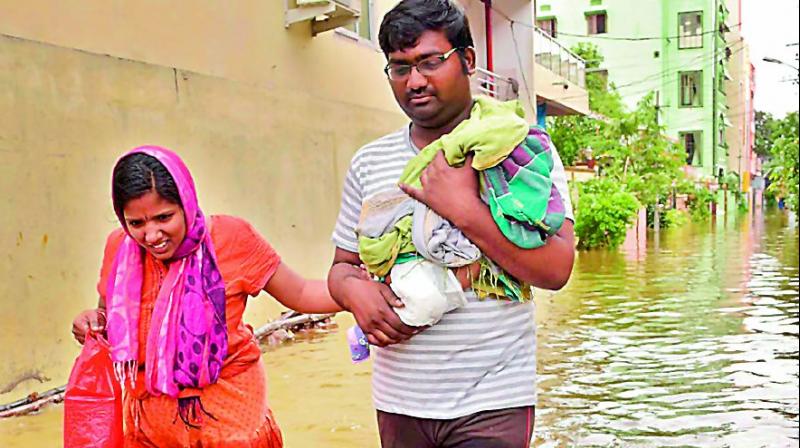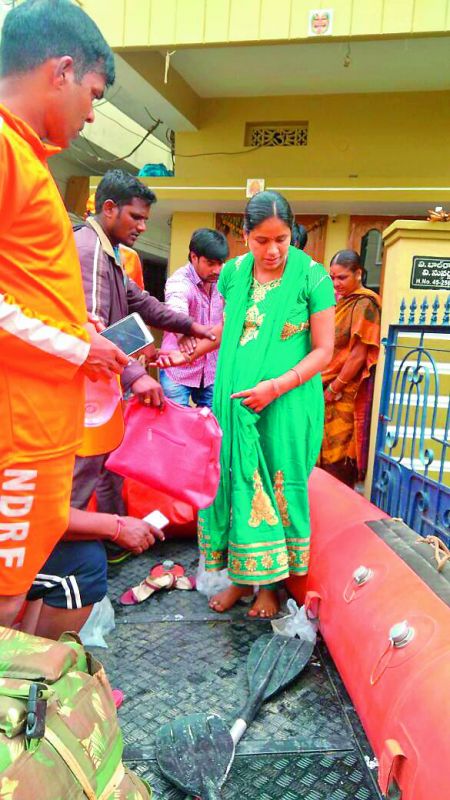Stories of struggle: Techies struggle to reach office, home

Hyderabad: IT employees and a few office-goers converted their homes to an office to avoid traffic jams. Some office-goers, whose request to work from home was turned down, reached the office at 11 am though they started from home at 8 am. It took them three hours to cover a distance of 8 km. Hitec City and Miyapur witnessed heavy traffic jams during the peak hours.
Residents of Nallagandala, Miyapur and nearby areas blamed the poor drainage system and bad roads for water clogging. The Madinaguda signal was completely clogged on Thursday morning. Two IT employees, had to walk 10kms in the night as they could not get any transport due to the rains. M. Deepak, an IT employee from Miyapur, said, “I know it was raining and I may get stuck in traffic. I called my wife to check on the situation. She asked me to stay at the office till 9 pm.” as it took her close to two hours to reach home on the same route."
He added, "I was done with my work and decided to leave my car in the office. Since I could not get a cab, I decided to walk. After 6 km, I got a cab from RTO office and reached home safely." Anik Dutta, a resident of Nallagandla and a commuter to Hitec City, said, "I used to commute daily from Nallagandla to Hitech City. After the heavy rains, roads became a nightmare for me. It took nearly two hours for me to reach home on Wednesday night and on Thursday morning it took more than an hour to reach the office. Bad roads, heavy loaded trucks and poorly lit streets are causing problems to travel on a rainy day."
 A pregnant woman from the NMDC colony in East Anandhbagh is helped onto the service boat of the NDRF on Thursday. (Photo: DC)
A pregnant woman from the NMDC colony in East Anandhbagh is helped onto the service boat of the NDRF on Thursday. (Photo: DC)
NDRF helps rescue pregnant woman
The NDRF had to press into service their boat to rescue a pregnant woman from the NMDC colony in East Anandhbagh in the wee hours of Thursday as the colony was isolated after the Bandacheruvu gave away due to the heavy rains that lashed the northern part of the city on Thursday. Over 600 families were trapped in their homes as water overflowed from drains and flooded the roads up to 8 feet high. “She was in acute labour pain and to avoid any untoward situation, she was taken to a safer place,” said inspector RP Chaudhary of NDRF. Many areas in East Anandhbagh gave away to the overflowing lake.
Ananth Saraswatinagar took a hit as over 10 apartments had their cellars filled. “It’s a dangerous situation and have hired a private pump to remove the water,” said Mr Ramesh, general secretary of the colony. A hospital in the area, Rishi Hospital, was also inundated with its equipment drenched in water and patients distressed. "The flooding began as early as 4pm on Wednesday. By night, I couldn't see my house as I returned," recollected Ms Karuna M. The overflow from the lake went downstream all the way to Lalapet where Chandra Babu Naidu colony was devastated and over 400 families evacuated and reinstated at the a local function hall.
GHMC officials reiterated that flooding was mainly due to encroachments on nalas. The water reached in gushing speeds to Nacharam Cheruvu and flooded many colonies. Over 1,500 residents were trapped in their homes as water flowed through roads to the Nalla Cheruvu downstream. The police cordoned off the road from Nacharaam Mallapur. "This is an urban flooding situation and we sought help of 20 officers with 5 boats," said Chaudhary added.
Nightmare for low-lying colonies
The flash rains kept awake several residents in low-lying colonies in Malkajgiri, Uppal and Secunderabad. An RTC bus at LB Nagar was stranded on the main road and had to be shifted with the help of a crane with five passengers stuck inside for an hour . Over ten localities plunged into darkness and 61 crucial water stagnation points obstructed traffic on Thursday morning. Trimulgherry football ground was turned into a swimming pool. Over 400 families had to be evacuated and housed in function halls.
At Uppal, houses in low-lying areas of Nacharam and Moula Ali were isolated as water from the nalla entered colonies. The GHMC deployed boats in Uppal and Malakgiri to reach the submerged colonies. So far, the city’s average rainfall is 9.28 cm against the monthly average of 13.29 cm.

